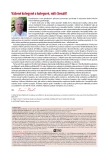Overactive bladder in the year 2013
Authors:
Jozef Marenčák
Authors‘ workplace:
Urologické oddelenie, Fakultná nemocnica s poliklinikou Skalica, primár doc. MUDr. Jozef Marenčák, PhD.
Published in:
Prakt Gyn 2013; 17(2): 141-145
Category:
Urogynecology: Review Article
Overview
Overactive bladder (OAB) is characterised by urgency and/ or urge incontinence (UI) – OAB dry or OAB wet – usually with frequency (more than 7 times/ day and more than 1 times/ night), in the absence of local pathological or endocrine factors. OAB is a highly prevalent, debilitating, and costly condition which has a negative impact on the patients´ quality of life. Author briefly reported about epidemiology, (possible) etiology and pathophysiology, diagnosis and therapy of OAB. Anticholinergic agents are the medication of first choice for patients with OAB, but they often have limitations due to side effects such as dry mouth. There were discussed another eventualities and perspectives (mostly) of conservative treatment of OAB.
Key words:
diagnosis of OAB – epidemiology of OAB – overactive bladder – therapy of OA
Sources
1. Abrams P, Cardozo L, Fall, M et al. The standardisation of terminology of lower urinary tract function. Neurourol Urodyn 2002; 21(1): 167–178.
2. Lucas M, Bedretdinova J, Bosch J et al. Guidelines on urinary incontinence. European Association of Urology: Arnhem 2013. ISBN 978–90–79754–71–7.
3. Abrams P, Cardozo L, Khoury S et al. Incontinence. ICUD-EAU: Paris 2013. ISBN 978–9953–493–21–3.
4. Franco I. Overactive bladder in children. J Urol 2007; 178(3): 761–768.
5. Marenčák J. Prevalence and associated factors of OAB in children. Presented in OAB Clinical Practice Forum, London, 24. – 25. 10. 2010.
6. Robinson D, Cardozo L. The overactive bladder syndrome in women. Informa Healthcare: London 2010. ISBN 978–1-84184–736–8.
7. Marenčák J. Inkontinencia moču – problém zdravotno-ekonomicko-sociálny. Elisabeth: Skalica 2011. ISBN 978–80–970567–1-1.
8. Hashim H, Abrams P. Overactive bladder syndrome and urinary incontinence. Oxford University Press: Oxford, New York 2012. ISBN 978–0-19–959939–4.
9. Blaivas J, Singh Purohit R. Diagnosis and treatment of overactive bladder. Oxford University Press: Oxford, New York 2011. ISBN 978–0-19–975372–7.
10. Wein A, Chapple C. Overactive bladder in clinical practice. Springer-Verlag: London 2012. ISBN 978–1-84628–830–2.
11. Shergill I, Arya M, Grange P et al. Medical therapy in Urology. Springer- Verlag: London 2010. ISBN 978–1-84882–704–2.
12. Marenčák J. Ľahká inkontinencia moču. Revue medicíny v praxi 2009; 7(3): 17–20.
13. Marenčák J. Ťažká inkontinencia moču u imobilných pacientov. Revue medicíny v praxi 2009; 7(5): 25–28.
14. Slack A, Newman D, Wein A. Bladder disorders. Health press limited: London 2011. ISBN 978–1-905832–96–5.
15. Jarvis G. Bladder drill. In: Freeman R, Malvern J. The unstable bladder. Wright: Bristol 1989. ISBN 0–9546956–8-2.
16. Marenčák J, Cossons N, Darekar A et al. Investigation of the clinical efficacy and safety of pregabalin alone or combined with tolterodine in female subjects with idiopathic overactive bladder. Neurourol Urodyn 2011; 30(1): 75–82.
Labels
Paediatric gynaecology Gynaecology and obstetrics Reproduction medicineArticle was published in
Practical Gynecology

2013 Issue 2
Most read in this issue
- Repeated sectio caesarea, over and over: case report
- Guidelines for the thyroid diseases diagnosis and management in pregnancy and women with fertility disorders
- Complications after ovarian stimulation in vitro fertilization require admission to surgery
- Myoinositol – new possibility in treatment of polycystic ovary syndrome
